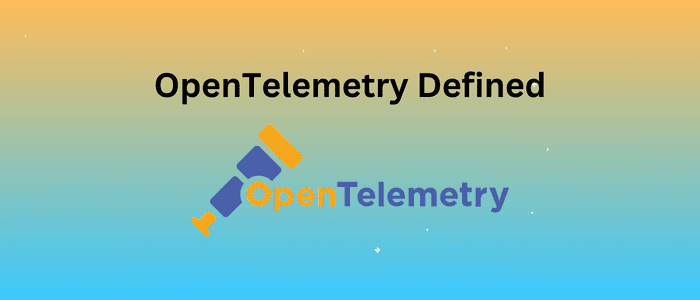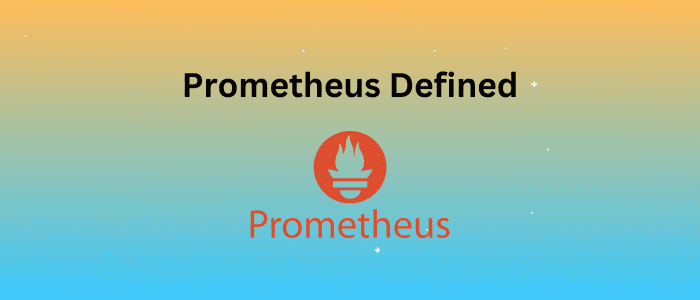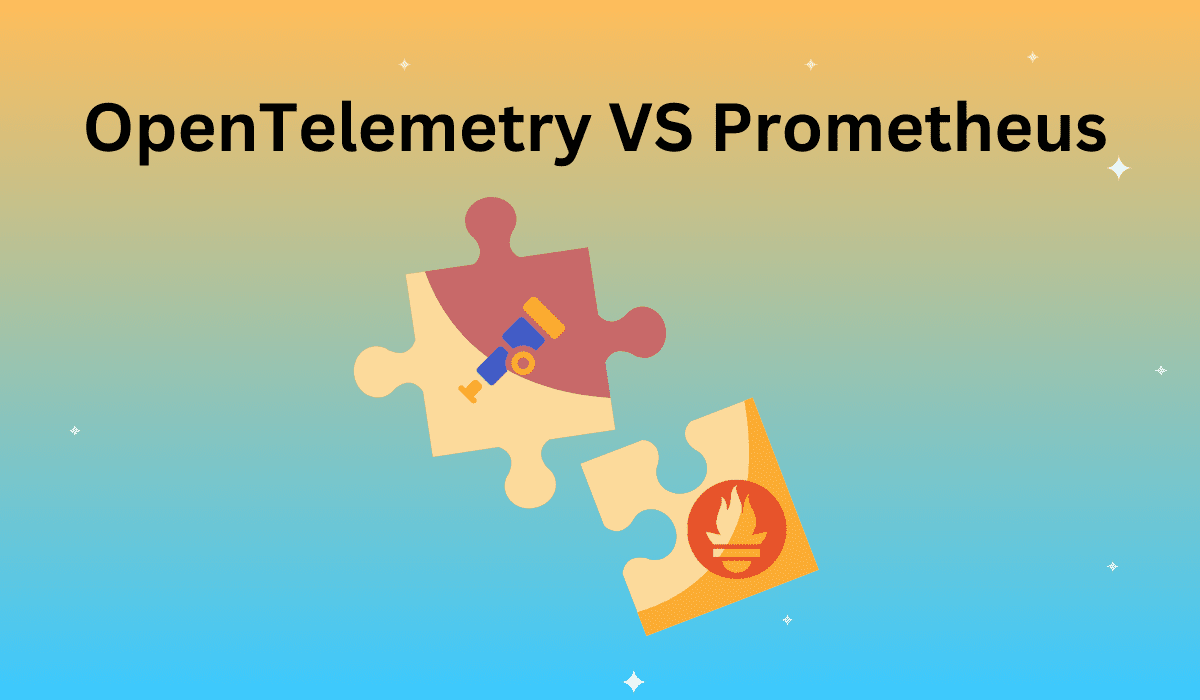OpenTelemetry vs Prometheus is a commonly searched and debated topic in the Observability and monitoring space. While both platforms are widely used in software and infrastructure management today, most people don’t understand the difference between the two.
Both platforms stand as robust tools in the realm of observability, each offering unique capabilities. OpenTelemetry offers a uniform approach for gathering, instrumenting, and exporting telemetry data. Prometheus, on the other hand, is distinguished by its proficiency in time-series data monitoring and its advanced alerting features.
In this blog post, we’ll take a deep dive into the key differences between OpenTelemetry VS Prometheus conundrum, shedding light on the respective strengths and merits they hold. Moreover, we’ll discuss the things to keep in mind before choosing one of the platforms, along with the integration aspects.
What is OpenTelemtery?

OpenTelemetry, commonly known as OTEL, is a comprehensive framework for observability, born from the amalgamation of two significant open-source initiatives: OpenTracing and OpenCensus. These projects were integrated with the shared objective of creating a standardized approach for code instrumentation and the transfer of telemetry data.
Presently, OpenTelemetry stands as the 2nd most active project within the Cloud Native Computing Foundation (CNCF), highlighting its escalating significance in the realm of observability.
The core highlights of OpenTelemetry include:
- Distributed Tracing
- Metrics Collection
- Context Propagation
- Instrumentation Libraries
- Opentelemetry Metrics
- Vendor-Agnostic
- Extensibility
- Opentelemetrycollector
What is Prometheus?

Prometheus is an open-source tool system that has been meticulously designed for reliability and scalability, specializing in the collection and storage of time-series data.
What sets Prometheus apart is its exceptional capability to monitor individual services and infrastructure components in real-time.
Some of the core features of Prometheus include:
- Pull-Based Metrics Collection
- Powerful Query Language
- Multi-Dimensional Data Model
- Efficient Time Series Database
- Robust Alerting
We’ll explore these features in more detail in the benefits section.
Prometheus has seen a significant rise in adoption among various industries. According to a survey by the Cloud Native Computing Foundation (CNCF), Prometheus is one of the top projects in terms of popularity and usage. This widespread adoption is a testament to its robustness and effectiveness in a cloud-native ecosystem.
Furthermore, Prometheus’s role in observability and monitoring, especially in Kubernetes environments, has become increasingly vital. Its integration capabilities with Kubernetes have made it a go-to choose for containerized application monitoring. This synergy with Kubernetes is a nuanced detail that illustrates Prometheus’s alignment with modern cloud-native architectures.
OpenTelemetry VS Prometheus: What’s the Difference?
OpenTelemetry and Prometheus are like two different tools in an engineer’s box. In a broader sense, both are observability tools but with varying functionalities and unique capabilities.
OpenTelemetry is a comprehensive toolkit designed for gathering detailed telemetry data from your applications. It’s sort of a multi-tool, collecting both traces, which are like detailed maps of a journey through your system, and metrics, which are akin to regular health check-ups.
Prometheus, in contrast, is more specialized. It acts as both a monitoring system and a time-series database, akin to a dedicated record-keeper that focuses primarily on metrics. These metrics are like snapshots of your system’s performance taken at regular intervals, offering a clear view of how things change over time.
The core difference lies in the type of data they handle and their collection methods. OpenTelemetry offers a broad view by capturing both traces and metrics.
While Prometheus sticks to a pull model, systematically fetching data from your services at set intervals, OTel follows both the push and pull combinations model for real-time data collection over prolonged periods.
Here’s a simplified summary of the differences between OpenTelemetry VS Prometheus in a table:
Feature | OpenTelemetry | Prometheus |
|---|---|---|
Main Function | Comprehensive toolkit for telemetry data collection | Specialized monitoring system and time-series database |
Data Types Supported | Traces, metrics, logs | Primarily metrics, with limited other data types |
Collection Model | Uses both push and pull models for real-time and prolonged data collection | Utilizes a pull model, systematically fetching data at set intervals |
Scalability and Performance | High scalability for large systems | Better for smaller-scale systems. |
Data Collection Method | Flexible: agent-based, sidecar, remote | Pull-based, scraping metrics periodically |
Aggregation and Querying | Custom aggregations, multi-dimensional querying | PromQL for advanced filtering and aggregation |
Integration with Ecosystem | Seamless integration with various systems and tools | Mature ecosystem, many exporters, and integrations |
Community and Adoption | Growing community, backed by industry players | Strong, active community widely adopted |
Benefits of OpenTelemetry
OpenTelemetry offers a range of benefits that make it an appealing choice for monitoring and observability in modern applications and systems. Its key advantages include:
- Comprehensive Signal Support: OTel supports various types of telemetry data, including traces, logs, and metrics. This provides a holistic view of system performance and behavior, allowing for more effective monitoring and troubleshooting.
- Vendor-Neutral Architecture: It is designed to be vendor-agnostic, meaning it can integrate with a wide variety of observability platforms, both open-source and commercial. This flexibility allows organizations to choose the tools that best fit their needs without being locked into a specific vendor.
- Standardization and Consistency: OpenTelemetry provides a consistent approach to collecting telemetry data across different applications and languages. This uniformity simplifies the process of instrumenting applications and reduces the complexity typically associated with varying monitoring tools.
- Automation and Reduced Error: OpenTelemetry automates many tasks related to telemetry data, such as data generation, organization, and analysis. This automation reduces the time and effort required from development teams and minimizes the chances of human error.
- Improved Operational Visibility: By providing detailed traces and metrics, OpenTelemetry enhances the visibility of application performance. This leads to quicker identification of issues, improved troubleshooting, and better overall system optimization with opentelemetry tracing example.
- Enhanced User Experience: Gaining insights into user interactions with applications helps in monitoring response times and tracking errors. This information is crucial for making improvements that positively impact on user satisfaction.
- Business Impact: The use of OpenTelemetry can lead to reduced downtime, optimized resource allocation, and data-driven decision-making. These benefits contribute to enhanced efficiency and competitiveness in the market.
- Future-Ready: As a project backed by the Cloud Native Computing Foundation (CNCF), OpenTelemetry aligns with industry standards and is well-positioned to evolve alongside emerging technologies and practices.
Benefits of Prometheus
Prometheus is a powerful tool for monitoring and alerting in complex, large-scale environments, particularly when integrated with Kubernetes and Grafana.
Following are its noteworthy benefits:
Real-time Monitoring and Alerting:
- Offers swift detection and response capabilities for system issues.
- Includes comprehensive system health tracking and problem identification.
- Can trigger alerts based on predefined criteria, enabling proactive system oversight.
Reliability and Efficiency:
- Prometheus is recognized for its robust performance in enterprise-scale monitoring.
- Utilizes a time-series database, ensuring constant availability of metrics data for analysis.
Kubernetes Integration:
- Ideal for Kubernetes environments due to seamless integration.
- Employs a data model with key-value pairs, aligning well with Kubernetes infrastructure metadata management.
Grafana Compatibility:
- Integrates efficiently with Grafana for advanced data visualization.
- Enables creation of dynamic, customizable dashboards for insightful real-time data interpretation.
Scalability and Flexibility:
- Designed to accommodate scalable environments with varying service discovery options.
- Features a modular architecture, encompassing metric collection, visualization, and alerting services.
- Supports sharding and redundancy, enhancing system resilience and availability.
Considerations and Limitations:
- Storage method may be resource-intensive, impacting server performance.
- Redundancy management could require multiple Prometheus instances.
- Event-driven metrics are not natively supported and may face network access limitations in certain setups.
Limitations of OpenTelemetry
OpenTelemetry excels as a unified telemetry collector, yet there are some limitations:
- Documentation/Support: Navigating the vast documentation and finding timely support can be cumbersome.
- No Built-in Analysis: OpenTelemetry lacks its own backend analysis, requiring integration with separate tools, adding complexity and vendor lock-in concerns.
- Feature Immaturity: Certain functionalities, particularly in metrics and logging, are still under development, limiting feature parity.
- Distributed Overhead: The distributed architecture can introduce performance overhead compared to centralized tracing solutions.
Limitations of Prometheus
Prometheus, while a valuable metrics monitoring tool, has several limitations:
- Limited Scope: Prometheus primarily captures metrics, lacking support for comprehensive monitoring by omitting logs and traces.
- Scaling Constraints: It is not designed for horizontal scaling, making it less suitable for large or dynamic scaling environments.
- Setup Complexity: Setting up Prometheus for effective visualization can be time-consuming and complex, requiring the configuration of exporters and Grafana panels.
- Lack of Root Cause Analysis: Prometheus falls short in providing root cause analysis capabilities since it does not support traces, making it less suitable for diagnosing complex issues.
OpenTelemetry VS Prometheus: Making a Choice

While most enterprises choose to use OpenTelemtry and Prometheus together, sometimes it’s better to stick with one depending on your specific requirements. When choosing between OpenTelemetry and Prometheus for your monitoring and observability needs, consider the following key points:
OpenTelemetry
- Holistic System View: OpenTelemetry excels in providing a comprehensive view of distributed system performance. It captures traces and context propagation across different services, crucial for understanding the end-to-end flow of requests.
- Ideal for Distributed Systems: It is particularly effective for understanding, troubleshooting, and monitoring distributed systems. OpenTelemetry helps in identifying latency issues in microservices architectures and provides insights into complex service interactions.
- Suitable for Complex Environments: Given its ability to trace requests across various services, OpenTelemetry is a strong choice for environments with complex service interactions and microservices.
Prometheus
- Component-focused Monitoring: Prometheus is highly effective in monitoring individual system components over time. It is particularly useful for tracking the performance and health of specific services or network devices.
- Alerting and Resource Utilization: Prometheus stands out for its alerting capabilities, capacity planning, and analysis of resource utilization. It helps in understanding how individual components of a system are performing and managing resources efficiently.
- Time-Series Metrics Specialization: Prometheus is well-suited for any components that emit time-series metrics. It is ideal for monitoring server resources, network devices, and individual services.
Decision-Making Factors
System Complexity: Choose OpenTelemetry for a broader, distributed system perspective and Prometheus for more focused, component-level monitoring.
Specific Needs: If your primary concern is understanding interactions and tracing in a distributed environment, OTel is preferable. For detailed analysis of individual component performance over time, Prometheus is more suitable.
Integration and Compatibility: Consider existing systems and tools for compatibility with either OpenTelemetry or Prometheus.
Long story short, OpenTelemetry is best for a holistic view of distributed systems and tracing, while Prometheus is ideal for detailed monitoring of specific components and time-series data analysis. The choice depends largely on the specific needs and architecture of your system.
Integrating OTel with Prometheus
Integrating OpenTelemetry with Prometheus involves merging two different data formats for enhanced observability and monitoring.
The integration is facilitated using the OpenTelemetry Collector, which acts as an intermediary, transforming Prometheus metrics into the OpenTelemetry format and forwarding them to various observability backends.
Reasons for Integrating OpenTelemetry with Prometheus
– Combined Capabilities: The integration brings together OpenTelemetry’s comprehensive tracing and metrics collection with Prometheus’s robust monitoring and alerting features. This combination offers a more complete overview of system performance.
– Enhanced Observability: OpenTelemetry provides a unified approach to traces and metrics, offering deep insights into application performance. When integrated with Prometheus, this results in real-time operational insights, enabling quick identification and resolution of issues.
– Consolidated Traces and Metrics: The integration allows for the collection, querying, and analysis of both traces and metrics in a single interface. This unification streamlines the process of managing telemetry data, especially in complex, distributed systems.
– Scalability and Performance: OpenTelemetry’s architecture is designed to efficiently handle distributed tracing and metrics collection. Prometheus complements this with its capability to manage large volumes of time-series data, ensuring the system remains performant even at scale.
– Data Visualization Flexibility: The integration provides extensive options for data visualization. OTel’s versatile data model captures a wide range of data types, which can then be analyzed and visualized using Prometheus’s PromQL. This functionality is further enhanced by Prometheus’s integration with Grafana, enabling the creation of dynamic and interactive dashboards for an in-depth view of application performance.
How to Integrate OpenTelemetry with Prometheus
- Using OpenTelemetry Collector: Set up the OpenTelemetry Collector as a proxy between your applications and the backend. Configure it to transform and export Prometheus metrics to an OTel-compatible backend.
- Configuring Data Export: Adjust the configuration to ensure seamless data conversion and export from Prometheus metrics to OpenTelemetry format.
- Leveraging Grafana for Visualization: Utilize Grafana for advanced visualization of the data collected and processed through this integrated setup.
Conclusion
OpenTelemetry and Prometheus both have their perks and limitations. Presently, they are widely used in the observability space and serve complementary roles when used together.
OpenTelemetry excels in aggregating telemetry data across services, while Prometheus is optimal for detailed monitoring of specific services and infrastructure over time.
While the OpenTelemtery VS Prometheus debate goes on, their combined use enhances the state of observability, leveraging OpenTelemetry’s data collection capabilities and Prometheus’s strengths in monitoring, alerting, and data storage. Therefore, the integrated apprach offers a robust solution for modern application monitoring needs.
In a Glimpse
OpenTelemetry offers comprehensive telemetry data collection, capturing traces, logs, and metrics.
Prometheus excels in monitoring individual components and time-series data analysis.
Choose OpenTelemetry for holistic system views and distributed systems, Prometheus for component-focused monitoring.
Integrating both enhances observability by combining strengths.
OpenTelemetry brings vendor-agnostic, automated, and standardized data collection.
Prometheus offers real-time monitoring, alerting, and Grafana compatibility.
Consider your system’s complexity and specific needs when deciding on OpenTelemetry VS Prometheus.
Integration is possible through the OpenTelemetry Collector, enhancing scalability and visualization.
The choice depends on your system architecture and monitoring requirements.











